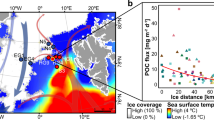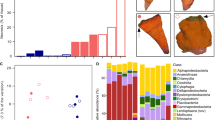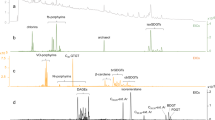Abstract
Continuing losses of multi-year sea ice (MYI) across the Arctic are causing first-year sea ice (FYI) to dominate the Arctic ice pack. Melting FYI provides a strong seasonal pulse of dissolved organic matter (DOM) into surface waters; however, the biological impact of this DOM input is unknown. Here we show that DOM additions cause important and contrasting changes in under-ice bacterioplankton abundance, production and species composition. Utilization of DOM was influenced by molecular size, with 10–100 kDa and >100 kDa DOM fractions promoting rapid growth of particular taxa, while uptake of sulfur and nitrogen-rich low molecular weight organic compounds shifted bacterial community composition. These results demonstrate the ecological impacts of DOM released from melting FYI, with wide-ranging consequences for the cycling of organic matter across regions of the Arctic Ocean transitioning from multi-year to seasonal sea ice as the climate continues to warm.
This is a preview of subscription content, access via your institution
Access options
Access Nature and 54 other Nature Portfolio journals
Get Nature+, our best-value online-access subscription
$29.99 / 30 days
cancel any time
Subscribe to this journal
Receive 12 print issues and online access
$209.00 per year
only $17.42 per issue
Buy this article
- Purchase on Springer Link
- Instant access to full article PDF
Prices may be subject to local taxes which are calculated during checkout




Similar content being viewed by others
Data availability
Experimental https://doi.org/10.5526/ERDR-00000072 and FT-ICR-MS data (https://doi.org/10.5526/ERDR-00000084) are available from the University of Essex data repository. Sequence data are archived at the European Bioinformatics institute, http://www.ebi.ac.uk, under accession number PRJEB20754.
References
Cohen, J. et al. Recent Arctic amplification and extreme mid-latitude weather. Nat. Geosci. 7, 627–637 (2014).
Stroeve, J. C., Markus, T., Boisvert, L., Miller, J. & Barrett, A. Changes in Arctic melt season and implications for sea ice loss. Geophys. Res. Lett. 41, 1216–1225 (2014).
Swart, N. C., Fyfe, J. C., Hawkins, E., Kay, J. E. & Jahn, A. Influence of internal variability on Arctic sea-ice trends. Nat. Clim. Change 5, 86–89 (2015).
Perovich, D. K. et al. Arctic Report Card 2015 (NOAA, 2015); https://www.arctic.noaa.gov/Report-Card/Report-Card-2015/ArtMID/5037/ArticleID/217/Sea-Ice
Clark, G. F. et al. Light driven tipping points in polar ecosystems. Glob. Change Biol. 19, 3749–3761 (2013).
Vancoppenolle, M. et al. Role of sea ice in global biogeochemical cycles: emerging views and challenges. Quat. Sci. Rev. 79, 207–230 (2013).
Krembs, C. & Deming, J. W. in Psychrophiles: from Biodiversity to Biotechnology (eds Margesin, R. et al.) 247–264 (Springer, Berlin, 2008).
Krembs, C., Eicken, H. & Deming, J. W. Exopolymer alteration of physical properties of sea ice and implications for ice habitability and biogeochemistry in a warmer Arctic. Proc. Natl Acad. Sci. USA 108, 3653–3658 (2011).
Underwood, G. J. C. et al. Broad-scale predictability of carbohydrates and exopolymers in Antarctic and Arctic sea ice. Proc. Natl Acad. Sci. USA 110, 15734–15739 (2013).
Aslam, S. N., Michel, C., Niemi, A. & Underwood, G. J. C. Patterns and drivers of carbohydrate budgets in ice algal assemblages from first year Arctic sea ice. Limnol. Oceanogr. 61, 919–937 (2016).
Leu, E. et al. Arctic spring awakening – steering principles behind the phenology of vernal ice algal blooms. Prog. Oceanogr. 139, 151–170 (2015).
Arctic Monitoring and Assessment Programme Snow, Water, Ice and Permafrost Summary for Policy-Makers (AMAP , Oslo, 2017).
Bowman, J. S. et al. Microbial community structure of Arctic multiyear sea ice and surface seawater by 454 sequencing of the 16S RNA gene. ISME. J. 6, 11–20 (2012).
Hatam, I., Lange, B., Beckers, J., Haas, C. & Lanoil, B. Bacterial communities from Arctic seasonal sea ice are more compositionally variable than those from multi-year sea ice. ISME J. 10, 2543–2552 (2016).
Verdugo, P. Marine microgels. Ann. Rev. Mar. Sci. 4, 375–400 (2012).
Benner, R. & Amon, R. M. W. The size-reactivity continuum of major bioelements in the ocean. Annu. Rev. Mar. Sci. 7, 185–205 (2015).
Amon, R. M. W., Fitznar, H. P. & Benner, R. Linkages among the bioreactivity, chemical composition, and diagenetic state of marine dissolved organic matter. Limnol. Oceanogr. 46, 287–297 (2001).
Riedel, A., Michel, C. & Gosselin, M. Seasonal study of sea-ice exopolymeric substances on the Mackenzie shelf: implications for transport of sea-ice bacteria and algae. Aquat. Microb. Ecol. 45, 195–206 (2006).
Juhl, A. R., Krembs, C. & Meiners, K. M. Seasonal development and differential retention of ice algae and other organic fractions in first-year Arctic sea ice. Mar. Ecol. Prog. Ser. 436, 1–16 (2011).
Smith, R. E. H., Gosselin, M., Kudoh, S., Robineau, B. & Taguchie, S. DOC and its relationship to algae in bottom ice communities. J. Mar. Syst. 11, 71–80 (1997).
Michel, C., Riedel, A. & Mundy, C. J. Biological Investigation of First-Year Sea Ice Near Resolute Bay, Nunavut, Spring to Early Summer 2001. Canadian Data Report of Hydrography and Ocean Sciences 160 (Government of Canada, 2003).
Riedel, A., Michel, C. & Gosselin, M. Grazing of large-sized bacteria by sea-ice heterotrophic protists onthe Mackenzie shelf during the winter–spring transition. Aquat. Microbiol. Ecol. 50, 25–38 (2017).
Meiners, K., Brinkmeyer, R., Granskog, M. A. & Lindfors, A. Abundance, size distribution and bacterial colonization of exopolymer particles in Antarctic sea ice (Bellingshausen Sea). Aquat. Microb. Ecol. 35, 283–296 (2004).
Niemi, A., Meisterhans, G. & Michel, C. Response of under-ice prokaryotes to experimental sea-ice DOM enrichment. Aquat. Microb. Ecol. 73, 17–28 (2014).
Assmy, P. et al. Floating ice-algal aggregates below melting Arctic sea ice. PLoS ONE 8, e76599 (2013).
Wilson, T. W. et al. A marine biogenic source of atmospheric ice-nucleating particles. Nature 525, 234–238 (2015).
Holding, J. M. et al. Autochthonous and allochthonous contributions of organic carbon to microbial food webs in Svalbard fjords. Limnol. Oceanogr. 62, 1307–1323 (2017).
Jørgensen, L., Stedmon, C. A., Kaartokallio, H., Middelboe, M. & Thomas, D. N. Changes in the composition and bioavailability of dissolved organic matter during sea ice formation. Limnol. Oceanogr. 60, 817–830 (2015).
Galindo, V. Biological and physical processes influencing sea ice, under-ice algae, and dimethylsulfoniopropionate during spring in the Canadian Arctic Archipelago. J. Geophys. Res. Oceans 119, 3746–3766 (2014).
Meiners, K. M. & Michel, C. in Sea Ice 3rd edn (ed. Thomas, D. N.) 415–432 (Wiley Blackwell, Oxford, 2017).
Aslam, S. N., Strauss, J., Thomas, D. N., Mock, T. & Underwood, G. J. C. Identifying metabolic pathways for production of extracellular polymeric substances (EPS) by the diatom Fragilariopsis cylindrus inhabiting sea ice. ISME J. 12, 1237–1251 (2018).
Sleighter, R. L. & Hatcher, P. G. The application of electrospray ionization coupled to ultrahigh resolution mass spectrometry for the molecular characterization of natural organic matter. J. Mass Spectrom. 42, 559–574 (2007).
Shen, Y., Fichot, C. G. & Benner, R. Dissolved organic matter composition and bioavailability reflect ecosystem productivity in the Western Arctic Ocean. Biogeosciences 9, 4993–5005 (2012).
Michel, C., Ingram, R. G. & Harris, L. R. Variability in oceanographic and ecological processes in the Canadian Arctic Archipelago. Prog. Oceanogr. 71, 379–401 (2006).
Niemi, A., Michel, C., Hille, K. & Poulin, M. Protist assemblages in winter sea ice: setting the stage for the spring ice algal bloom. Polar Biol. 34, 1803–1817 (2011).
Chin, W., Orellana, M. V. & Verdugo, P. Spontaneous assembly of marine dissolved organic matter into polymer gels. Nature 391, 568–572 (1998).
Mundy, C. J. et al. Role of environmental factors on phytoplankton bloom initiation under landfast sea ice in Resolute Passage, Canada. Mar. Ecol. Prog. Ser. 497, 38–49 (2014).
Elliott, A. et al. Spring production of mycosporine-like amino acids and other UV-absorbing compounds in sea ice-associated algae communities in the Canadian Arctic. Mar. Ecol. Prog. Ser. 541, 91–104 (2015).
Arnosti, C. & Steen, A. Patterns of extracellular enzyme activities and microbial metabolism in an Arctic fjord of Svalbard and in the northern Gulf of Mexico: contrasts in carbon processing by pelagic microbial communities. Front. Microbiol. 4, 1 (2013).
Steen, A. D. & Arnosti, C. Picky, hungry eaters in the cold: persistent substrate selectivity among polar pelagic microbial communities. Front. Microbiol. 5, 527 (2014).
Teeling, H. et al. Recurring patterns in bacterioplankton dynamics during coastal spring algae blooms. eLife 5, e11888 (2016).
Sipler, R. E. et al. Microbial community response to terrestrially derived dissolved organic matter in the coastal Arctic. Front. Microbiol. 8, 1018 (2017).
Ortega-Retuerta, E. et al. Carbon fluxes in the Canadian Arctic: patterns and drivers of bacterial abundance, production and respiration on the Beaufort Sea margin. Biogeosciences 9, 3679–3692 (2012).
Kirchman, D. L. et al. Standing stocks, production, and respiration of phytoplankton and heterotrophic bacteria in the western Arctic Ocean. Deep Sea Res. Part 2 Top. Stud. Oceanogr. 56, 1237–1248 (2009).
Arnosti, C. Microbial extracellular enzymes in the marine carbon cycle. Annu. Rev. Mar. Sci. 3, 401–425 (2011).
Troussellier, M., Bouvy, M., Courties, C. & Dupuy, C. Variation of carbon content among bacterial species under starvation conditions. Aquat. Microb. Ecol. 13, 113–119 (1997).
Hansell, D. A. & Carlson, C. A. Dissolved organic matter in the ocean: a controversy stimulates new insights. Oceanography 22, 202–211 (2009).
Ksionzek, K. B. et al. Dissolved organic sulfur in the ocean: biogeochemistry of a petagram inventory. Science 354, 456–459 (2016).
Yergeau, E. et al. Metagenomic survey of the taxonomic and functional microbial communities of seawater and sea ice from the Canadian Arctic. Sci. Rep. 7, 42242 (2017).
Zeng, Y. et al. Phylogenetic diversity of planktonic bacteria in the Chukchi Borderland region in summer. Acta Oceanologica Sininica 32, 66–74 (2013).
Pedrós-Alió, C., Potvin, M. & Lovejoy, C. Diversity of planktonic microorganisms in the Arctic Ocean. Prog. Oceanogr. 139, 233–243 (2015).
Parada, A. E., Needham, D. M. & Fuhrman, J. A. Every base matters: assessing small subunit rRNA primers for marine microbiomes with mock communities, time series and global field samples. Environ. Microbiol. 18, 1403–1414 (2015).
Herlemann, D. P. R. et al. Transitions in bacterial communities along the 2000 km salinity gradient of the Baltic Sea. ISME J. 5, 1571–1579 (2011).
Deming, J. W. & Collins, R. E. in Sea Ic e 3rd edn (ed. Thomas, D. N.) 326–351 (Wiley, Oxford, 2017).
Methé, B. A. et al. The psychrophilic lifestyle as revealed by the genome sequence of Colwellia psychrerythraea 34H through genomic and proteomic analyses. Proc. Natl Acad. Sci. USA 102, 10913–10918 (2005).
Bohórquez, J. et al. Different types of diatom-derived extracellular polymeric substances drive changes in heterotrophic bacterial communities from intertidal sediments. Front. Microbiol. 8, 245 (2017).
Frette, L., Jørgensen, N. O., Irming, H. & Kroer, N. Tenacibaculum skagerrakense sp. nov., a marine bacterium isolated from the pelagic zone in Skagerrak, Denmark. Int. J. Syst. Evol. Microbiol. 54, 519–524 (2004).
Groudieva, T., Grote, R. & Antranikian, G. Psychromonas arctica sp. nov., a novel psychrotolerant, biofilm-forming bacterium isolated from Spitzbergen. Int. J. Syst. Evol. Microbiol. 53, 539–545 (2003).
Lange, B. A. et al. Comparing springtime ice-algal chlorophyll a and physical properties of multi-year and first-year sea ice from the Lincoln Sea. PLoS ONE 10, e0122418 (2015).
Thingstad, T. F., Våge, S., Storesund, J. E., Sandaa, R.-A. & Giske, J. A theoretical analysis of how strain-specific viruses can control microbial species diversity. Proc. Natl Acad. Sci. USA 111, 7813–7818 (2014).
Logvinova, C. L., Frey, K. E., Mann, P. J., Stubbins, A. & Spencer, R. G. M. Assessing the potential impacts of declining Arctic sea ice cover on the photochemical degradation of dissolved organic matter in the Chukchi and Beaufort Seas. J. Geophys. Res. Biogeosci. 120, 2326–2344 (2015).
Horvat, C. et al. The frequency and extent of sub-ice phytoplankton blooms in the Arctic Ocean. Sci. Adv. 3, e1601191 (2017).
Anderson, L. G., & Amon, R. M. W. in Biogeochemistry of Marine Dissolved Organic Matter 2nd edn (eds Hansell, D. A. & Carlson, C. A.) 609–633 (Academic Press, Boston, 2015).
Elliot, S. et al. Strategies for the simulation of sea ice organic chemistry: Arctic tests and development. Geosciences 7, 52 (2017).
Zhou, J., Mopper, K. & Passow, U. The role of surface active carbohydrates in the formation of transparent exopolymer particles by bubble adsorption of seawater. Limnol. Oceanogr. 43, 1860–1871 (1998).
Underwood, G. J. C., Fietz, S., Papadimitriou, S., Thomas, D. N. & Dieckmann, G. S. Distribution and composition of dissolved extracellular polymeric substances (EPS) in Antarctic Sea Ice. Mar. Ecol. Prog. Ser. 404, 1–19 (2010).
Norman, L. et al. The role of bacterial and algal exopolymeric substances in iron chemistry. Mar. Chem. 186, 148–161 (2015).
Grasshoff, K., Kremling, K. & Ehrhardt, M. (eds) Methods of Seawater Analysis 3rd edn (Wiley, 1999).
Knap, A., Michaels, A., Close, A., Ducklow, H. & Dickson, A. Protocols for the Joint Global Ocean Flux Study (JGOFS) Core Measurements, JGOFS Report No. 19, Reprint of the IOC Manuals and Guides No. 29, UNESCO 1994 (JGOFS, 1996).
Dubois, M., Gilles, K. A., Hamilton, J. K., Rebers, P. A. & Smith, F. Colorimetric method for determination of sugars and related substances. Anal. Chem. 28, 350–356 (1956).
Decho, A. W. Microbial exopolymer secretions in ocean environments: their role(s) in food webs and marine processes. Oceanogr. Mar. Biol. Annu. Rev. 28, 73–153 (1990).
Herborg, L.-M., Thomas, D. N., Kennedy, H., Haas, C. & Dieckmann, C. Dissolved carbohydrates in Antarctic sea ice. Antarct. Sci. 13, 119–125 (2001).
Sutherland, I. Biofilm exopolysaccharides: a strong and sticky framework. Microbiology 147, 3–9 (2001).
Dittmar, T., Koch, B. P., Hertkorn, N. & Kattner, G. A simple and efficient method for the solid-phase extraction of dissolved organic matter (SPE-DOM) from seawater. Limnol. Oceanogr. Methods 6, 230–235 (2008).
Koch, B. P., Kattner, G., Witt, M. & Passow, U. Molecular insights into the microbial formation of marine dissolved organic matter: recalcitrant or labile? Biogeosciences 11, 4173–4190 (2014).
Lechtenfeld, O. J. et al. The influence of salinity on the molecular and optical properties of surface microlayers in a karstic estuary. Mar. Chem. 150, 25–38 (2013).
Marie, D., Partensky, F., Jacquet, S. & Vaulot, D. Enumeration and cell cycle analysis of natural populations of marine picoplankton by flow cytometry using the nucleic acid stain SYBR Green I. Appl. Env. Microbiol. 63, 186–193 (1997).
Gasol, J. M., Zweifel, U. L., Peters, F., Fuhrman, J. A. & Hagström, Å. Significance of size and nucleic acid content heterogeneity as measured by flow cytometry in natural planktonic bacteria. Appl. Environ. Microbiol. 65, 4475–4483 (1999).
Cosa, G., Focsaneanu, K. S., McLean, J. R. N., McNamee, J. P. & Scaiano, J. C. Photophysical properties of fluorescent DNA-dyes bound to single- and double-stranded DNA in aqueous buffered solution. Photochem. Photobiol. 73, 585–599 (2001).
Smith, D. C. & Azam, F. A simple, economical method for measuring bacterial protein synthesis rates in seawater using 3H-leucine. Mar. Microb. Food Webs 6, 107–114 (1992).
Herndl, G. J. et al. Contribution of Archaea to total prokaryotic production in the deep Atlantic Ocean. Appl. Environ. Microbiol. 71, 2303–2309 (2005).
Garneau, M.-E. et al. Hydrocarbon biodegradation by Arctic sea-ice and sub-ice microbial communities during microcosm experiments, Northwest Passage (Nunavut, Canada). FEMS Microbiol. Ecol. 92, fiw130 (2016).
Caporaso, J. G. et al. QIIME allows analysis of high-throughput community sequencing data. Nat. Methods 7, 335–336 (2010).
Quince, C., Lanzen, A., Davenport, R. J. & Turnbaugh, P. J. Removing noise from pyrosequenced amplicons. BMC Bioinformatics 12, 38 (2011).
Edgar, R. C., Haas, B. J., Clemente, J. C., Quince, C. & Knight, R. UCHIME improves sensitivity and speed of chimera detection. Bioinformatics 27, 2194–2200 (2011).
Wang, Q., Garrity, G. M., Tiedje, J. M. & Cole, J. R. Naïve Bayesian classifier for rapid assignment of rRNA sequences into the new bacterial taxonomy. Appl. Environ. Microbiol. 73, 5261–5267 (2007).
Rognes, T., Flouri, T., Nichols, B., Quince, C. & Mahé, F. VSEARCH: a versatile open source tool for metagenomics. PeerJ 4, e2584 (2016).
Bray, J. C. & Curtis, J. T. An ordination of the upland forest communities of southern Wisconsin. Ecol. Monogr. 27, 325–349 (1957).
Acknowledgements
G.J.C.U. was funded by grants no. NE/D00681/1 and no. NE/E016251/1 from the UK Natural Environment Research Council. C.M. received financial support from the Natural Sciences and Engineering Council of Canada (Individual Discovery Grant), the International Governance Strategy (Fisheries and Oceans Canada) and the Polar Continental Shelf Program (Natural Resources Canada) for the project Sea Ice BIOTA (Biological Impacts of Trends in the Arctic). G.M. received a Visiting Fellowship in Canadian Government Laboratory from the Natural Sciences and Engineering Council of Canada. C. Burau is acknowledged for performing solid-phase extraction. We thank S. Duerksen, D. Jordan, M. Poulin and A. Reppchen for their help in the field and laboratory. We also appreciate support from the Resolute Bay Hunters and Trappers Association and the logistical support from the Polar Continental Shelf Program in Resolute, Nunavut.
Author information
Authors and Affiliations
Contributions
G.J.C.U., C.M. and A.N. designed the study. G.J.C.U., C.M. and G.M. conducted the experiments. M.W. carried out FT-ICR-MS analysis. G.J.C.U., C.M., C.B., G.M., A.N., B.P.K. and A.J.D. analysed the data. G.J.C.U., C.M., B.P.K. and A.J.D. wrote the manuscript.
Corresponding author
Ethics declarations
Competing interests
The authors declare no competing interests.
Additional information
Journal peer review information: Nature Climate Change thanks David Kirchman and other anonymous reviewer(s) for their contribution to the peer review of this work.
Publisher’s note: Springer Nature remains neutral with regard to jurisdictional claims in published maps and institutional affiliations.
Supplementary information
Supplementary Information
Supplementary Figures 1–15, Supplementary Tables 1–4, Supplementary Methods, Supplementary Note, Supplementary References.
Rights and permissions
About this article
Cite this article
Underwood, G.J.C., Michel, C., Meisterhans, G. et al. Organic matter from Arctic sea-ice loss alters bacterial community structure and function. Nature Clim Change 9, 170–176 (2019). https://doi.org/10.1038/s41558-018-0391-7
Received:
Accepted:
Published:
Issue Date:
DOI: https://doi.org/10.1038/s41558-018-0391-7
This article is cited by
-
Salinity-controlled distribution of prokaryotic communities in the Arctic sea-ice melt ponds
World Journal of Microbiology and Biotechnology (2024)
-
Potential transformation of organic matter by microbes in cryoconite, Tibetan Plateau
Science China Earth Sciences (2024)
-
Atlantic water influx and sea-ice cover drive taxonomic and functional shifts in Arctic marine bacterial communities
The ISME Journal (2023)
-
The role of a changing Arctic Ocean and climate for the biogeochemical cycling of dimethyl sulphide and carbon monoxide
Ambio (2022)
-
Management implications of long transients in ecological systems
Nature Ecology & Evolution (2021)



